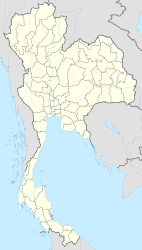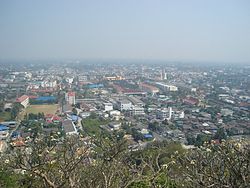Phetchaburi
|
เพชรบุรี Phetchaburi |
||
|---|---|---|
|
|
||
| Coordinates | 13 ° 7 ' N , 99 ° 57' E | |
| Basic data | ||
| Country | Thailand | |
| Phetchaburi | ||
| ISO 3166-2 | TH-76 | |
| Residents | 26,181 (2005) | |
|
View over the city from Khao Wang
|
||
Phetchaburi ( Thai : เพชรบุรี , pronounced: [pʰétt͡ɕʰáʔbùʔriː] , colloquially [pʰétbùʔriː] , translated: "Diamond City") is the capital of the district ( Amphoe ) Mueang Phetchaburi and the province of Phetchaburi . Phetchaburi Province is located in the southwestern part of the central region of Thailand .
location
Phetchaburi is located in the middle of high mountain ranges about ten kilometers from the confluence of Maenam Phetchaburi in the Gulf of Thailand and about 170 kilometers southwest of the state capital Bangkok .
The main river in the county is the Phetchaburi River, which splits into three arms to the sea: Bang Tabun Noi, Bang Tabun Yai, and Bang (Ban) Laem. But it cannot be used by larger boats or even ships.
traffic
Road traffic
Phetchaburi is on National Road 4 ( Thanon Phetkasem ). The travel time to Bangkok by car or bus is around 2 hours.
Rail transport
Petchaburi has a train station on the Southern Railway , which connects Bangkok with Malaysia .
history
Phetchaburi has a long and rich history. Phetchaburi was originally a Mon settlement ( 8th century ). In the course of the expansion of the Khmer , the city became a religious center in the 11th century . After King Ramkhamhaeng Phetchaburi wrested the Khmer and annexed it to the kingdom of Sukhothai , it came to the kingdom of Ayutthaya after its decline . The city experienced a bizarre break in history when it was captured by Japanese pirates in 1610, who declared themselves independent. About 200 years ago the city was close to the sea, but was separated from the sea by the heavy sedimentation of Maenam Phetchaburi.
At the beginning of the 19th century there was a weak wooden fortification which, together with the Siamese garrison, served to protect against the Burmese. At that time there were frequent quarrels between the population of Phetchaburi and the garrison, which apparently was getting too massive a supply. The government in Bangkok therefore warned the soldiers not to stir up a dispute.
In 1831 and 1832 the government sent men from Phetchaburi to Songkhla to fight against insurgents from Pattani .
Attractions
- Phra Nakhon Khiri - King Mongkut's royal palace on the 95 m high Khao Wang mountain; built in 1853/1860 in European-neoclassical style for the king's astronomical research. King Chulalongkorn often used the palace to receive state guests. Today the palace is a museum for archaeological and art objects. - On the western hill of the three-hill mountain is the palace (with temple and observatory ); on a middle hill a white chedi , and on the northeast hill the temple Wat Phra Kaeo Noi (in Thai : วัด พระ แก้ว น้อย ) with a prang painted in dark red .
- Phra Ram Ratchaniwet Palace (in Thai: พระราม ราช นิเวศน์ ) - in popular usage simply called Ban Puen Palace ( วัง บ้าน ปืน ) (and occasionally also called Phra Ratchawang Ban Peun ) - is a palace villa that King Chulalongkorn bought shortly before his death in 1910 Had given order. It is located in the southeast of the urban area of Phetchaburi, within a military facility. The Art Deco building by the German architect Karl Döhring , completed around 1916, is reminiscent of the theater buildings by Oskar Kaufmann , which were very popular in Germany during those years. A green tiled, snail-like staircase, supported by columns and spanned by a partially glazed dome, is the eye-catcher of the building; the dining room on the upper floor is lined with yellow tiles.
- Wat Yai Suwannaram (Thai: วัด ใหญ่ สุวรรณาราม ) - the most beautiful Buddhist temple in the city. Worth seeing: the viharn from the 17th century with wall paintings from the Ayutthaya period, old library ( Hor Trai ) on stilts in a picturesque lake with lots of fish, ...
- Wat Ko Kaeo Sutharam - Monastery complex ( Wat ) on the river bank of Maenam Phetchaburi, built on stilts and hardly changed for centuries, wall painting of a Jesuit in the robe of a Buddhist monk.
- Wat Mahathat Worawihan (Thai: วัด มหาธาตุ วรวิหาร ) - Ayutthaya-style monastery complex with a slender, central prang that towers above the old cityscape.
- Wat Khamphaeng Laeng (Thai: วัดกำแพง แลง ) - ruined monastery of the Khmer with stone wall and laterite - prang from the time of Jayavarman VII. (12th century). One of the prang encloses a footprint of the Buddha .
- Tham Khao Luang ( ถ้ำ เขา หลวง ) - stalactite cave about 3 kilometers north of the city center of Phetchaburi. In the cave there is a row of seated Buddha images and a central Buddha statue. At certain times the sunlight falls into the cave, which creates a special light impression
Individual evidence
- ↑ Terwiel (1989), p. 77
literature
- Barend Jan Terwiel : Trough Travelers' Eyes: an approach to nineteenth century Thai history . Bangkok: Duang Kamol 1989. ISBN 974-210-455-7 .
Web links
- City map of Phetchaburi (names in English and Thai - last accessed November 28, 2015)












